-
Nuclear β-decay is a process that involves the spontaneous conversion of one kind of nucleon into another accompanied by the emission of electron (or positron) and antineutrino (neutrino). As one of the main decay modes of unstable nuclei [1, 2], it can provide information on the spin and isospin dependence of the effective nuclear interaction and also on nuclear properties such as masses [3], shapes [4−6], and energy levels [7−9]. The origin of heavy elements in the universe has been one of the most extensively studied but least understood topics in nuclear astrophysics [10, 11]. In particular, about half of the elements heavier than iron are produced by the rapid-neutron capture process (r-process). Nuclear β-decay half-lives set the time scale of the r-process and are important nuclear physics inputs for r-process simulations [12−15]. Therefore, the study of nuclear β-decay half-lives is of great value to nuclear physics and nuclear astrophysics [16−18]. However, most of the nuclei involved in the r-process are far away from the β stability line and cannot be accessed by the present experimental facilities, necessitating reliance on theoretical models for the prediction of the β-decay properties of those nuclei.
Theoretical models for the nuclear β-decay half-life studies include the gross theory [19−22], shell model [13, 23−25], quasiparticle random-phase approximation (QRPA) method [26−30], and empirical formulas in various forms [31−34]. The gross theory, which is a macroscopic model based on a summation rule for β-decay strength function, treats the transitions to all final nuclear levels statistically. By introducing various microscopic effects, such as the spin-parity property [35] and spin-orbit splitting [36], the accuracy of gross theory can be improved to a level even higher than those of the microscopic models although some microscopic effects of gross theory would certainly be missing due to its statistical nature. However, the microscopic shell model configuration interaction approach can provide details of the β-strength function but is often limited by the computation in large configuration spaces to studying the nuclear β-decay half-lives of light nuclei or nuclei close to the magic number. The QRPA method can be applied to most nuclei in the nuclear chart except for a few very light nuclei [37−40], whereas the conventional QRPA calculations in matrix form can be very time-consuming. The finite-amplitude method (FAM) was developed to solve the QRPA equations [41, 42] and has been recently used to study the half-lives of medium-mass and heavy neutron-rich isotopes [43, 44]. However, the computation speed is still a highly limiting factor for studying all the nuclei involved in the r-process, and its accuracy still needs to be improved in comparison to other nuclear β-decay models. Therefore, constructing high-precision empirical formulas, which is much less time-consuming because of their simple form, can be the most promising and practical choice for systematically describing nuclear β-decay half-lives. Therefore, we aimed for a simple formula that can describe the available experimental β-decay half-lives with high accuracy with approximately
$ 10 $ parameters.An empirical formula with higher prediction accuracy may be achieved by including more physical terms with their parameters determined by fitting to the experimental nuclear β-decay half-lives [32, 45]. Apart from the proton number Z and neutron number N, the calculation of the nuclear β-decay half-life with the empirical formula usually only requires the β-decay energy
$ Q_\beta $ , which can be calculated from the nuclear masses. At this point, the empirical formula of β-decay half-lives can be used to construct self-consistent nuclear β-decay half-life tables for various nuclear mass models, which is crucial for r-process studies, especially for the evaluation of the uncertainties of r-process abundances from the nuclear physical inputs. The empirical formula for the β-decay half-lives can be traced back to the Sargent law [46], which states that the nuclear β-decay half-lives are proportional to the fifth power of the maximum energy of the emitted electron. The Sargent law explains the$ Q_\beta $ value dependence of the β-decay half-life; however, the prediction accuracy of this approximation is rather low because nuclear structure effects, such as the shell effect, pairing effect, and isospin dependence, are ignored. By further including these nuclear structure effects, the prediction accuracies of the empirical formulas have been improved remarkably [31, 32, 34].In addition to the
$ Q_\beta $ , the β-decay transition strength also plays an important role in half-life predictions. However, the transition-strength contribution is neglected in most existing empirical formulas. Recently, an empirical formula for the Gamow-Teller transition strength has been proposed [47] based on the Ikeda sum rule [48], isospin symmetry, and isospin limit condition. Based on this study on transition strength, a new empirical formula for the nuclear β-decay half-lives is constructed in this work. The prediction accuracy and extrapolation ability of the new empirical formula are investigated by comparing its predictions with the experimental β-decay half-lives, microscopic nuclear model predictions, and those from other empirical formulas. The construction of the empirical formula is provided in Sec. II. The corresponding results and discussion are povided in Sec. III. The summary and perspective are presented in Sec. IV. -
Based on the Fermi theory of β-decay [49], nuclear β-decay half-life
$ T_{1/2} $ in the allowed Gamow-Teller approximation is$ T_{1/2}=\frac{D}{g^2_A\sum_m B_{if_m}f(Z,E_m)}, $

(1) where
$ D=2(\ln2)\pi^3\hbar^7/(m_e^5c^4g^2)=6163.4 $ s and$ g_A=1 $ .$ B_{if_m} $ denotes the transition strength from the parent nucleus initial state i to the final state$ f_m $ of the daughter nucleus, and$ f(Z,E_m) $ is the integrated phase volume, which can be calculated by$ f(Z,E_{m})=\frac{1}{m_e^5 c^7}\int_{0}^{p_{m}}F(Z,E_{e})(E_m-E_e)^2 p_e^{2} {\rm d} p_e, $

(2) where
$ m_e $ ,$ p_e $ ,$ E_e $ ,$ p_m $ ,$ E_m $ , and$ F(Z,E_e) $ denote the mass, momentum, energy, maximum momentum, maximum energy, and Fermi function of the emitted electron, respectively.For nuclei with
$ E_m \gg m_ec^2 $ , further approximating the Fermi integral function by taking$ F(Z,E_e)\approx 1 $ , yields$ f(Z,E_m) =\frac{E_m^5}{30m_e^5c^{10}}. $

(3) If only the transition from the ground state of the parent nucleus to the ground state of the daughter nucleus is considered, by combining Eqs. (1) and (3), one can obtain:
$ \ln(T_{1/2})=\ln(30Dm_{e}^{5}c^{10})-\ln(\sum\limits_m B_{if_m})-5\ln(E_{m}). $

(4) Neglecting the contribution of transition strength, setting the constants as free parameters
$ a_1 $ and$ a_2 $ , and taking$ E_{m}=Q_{\beta}+m_{e}c^{2} $ , an empirical formula of the nuclear β-decay half-lives, namely$ F_1 $ , is obtained.$ \begin{array}{*{20}{l}} F_1:\ln(T_{1/2})=a_1-a_2\ln(Q_\beta+m_ec^2). \end{array} $

(5) To improve the performance of the empirical formula, the odd-even effect term
$ \delta(Z, N)=(-1)^Z+(-1)^N $ and the shell effect correction term$ S(Z, N) $ were further introduced as in [32] and [45], thereby obtaining another empirical formula$ F_2 $ , as follows:$ \begin{array}{*{20}{l}} \begin{aligned} F_2:\ln(T_{1/2})=a_{1}-a_{2}\ln\left(Q_{\beta}+m_{e}c^{2}+a_{3}\delta\right) +S(Z,N), \end{aligned} \end{array} $

(6) with
$ \begin{aligned}[b] S(Z,N) =\;&a_{4}{\rm e}^{-[(Z-20)^{2}+(N-24)^{2}]/30}+a_{5}{\rm e}^{-[(Z-40)^{2}+(N-50)^{2}]/40} \\ &+a_{6}{\rm e}^{-[(Z-56)^{2}+(N-82)^{2}]/34}+a_{7}{\rm e}^{-[(Z-82)^{2}+(N-132)^{2}]/11}. \end{aligned} $

(7) The contribution of transition strength
$\displaystyle\sum_m B_{if_m}$ is neglected in empirical formulas$ F_1 $ and$ F_2 $ , while retaining structure effects as well as$ \delta(Z, N) $ and$ S(Z, N) $ for the empirical formula$ F_2 $ .Recently, an empirical formula of the Gamow-Teller transition strength was proposed based on the Ikeda sum rule, isospin symmetry, and isospin limit condition in [47], as follows:
$ \begin{array}{*{20}{l}} \sum B_{ {\rm{GT-}}}=3(Z{\rm e}^{-N/Z}+N{\rm e}^{-Z/N}+N-Z)/2. \end{array} $

(8) By further introducing the contribution of transition strength, a new empirical formula
$ F_3 $ is obtained:$ \begin{aligned}[b] F_3:\ln(T_{1/2})=\;& a_{1} -a_{2}\ln\left(Q_{\beta}+m_{e}c^{2}+a_{3}\delta\right)+S(Z,N) \\ &- a_{8}\ln(Z{\rm e}^{-N/Z}+N{\rm e}^{-Z/N}+N-Z). \end{aligned} $

(9) In this study, we calculated the
$ Q_\beta $ values from the nuclear mass predictions of the Weizsäcker-Skyrme mass model (WS4) [50]. The experimental half-lives were taken from NUBASE2020 [2], retaining only the data for nuclei$ Z,\; N\geqslant8, $ $ Q_\beta>0 $ ,$ T_{1/2}<10^6\; {\rm{s}} $ , decaying$ 100\% $ according to the$ \beta^- $ mode. By fitting to the experimental half-lives, the parameters of the empirical formulas$a_i\; (i=1, 2,\cdots)$ can be determined, as shown in Table 1.Formula $ a_1 $ 

$ a_2 $ 

$ a_3 $ 

$ a_4 $ 

$ a_5 $ 

$ a_6 $ 

$ a_7 $ 

$ a_8 $ 

$ F_1 $ 

12.267 5.712 — — — — — — $ F_2 $ 

12.254 6.035 0.540 4.989 6.331 3.492 1.188 — $ F_3 $ 

14.608 6.164 0.545 3.985 5.882 3.610 1.608 0.498 Table 1. The parameters of empirical formulas
$ F_1 $ ,$ F_2 $ , and$ F_3 $ .To evaluate the accuracies of empirical formulas for nuclear β-decay half-lives, we used the root-mean-square (rms) deviation of the logarithm of the half-life
$ \sigma_{{\rm{rms}}}(\log_{10}T_{1/2}^{{\rm{Th}}}) $ ,$ \sigma_{{\rm{rms}}}(\log_{10}T_{1/2}^{{\rm{Th}}})=\sqrt{\frac{1}{n}\sum\limits_{i=1}^{n} \left[\log_{10}(T_{1/2}^{{\rm{Th}}}/T_{1/2}^{{\rm{Exp}}})\right]_i^{2}}, $

(10) where
$ T_{1/2}^{{\rm{Th}}} $ and$ T_{1/2}^{{\rm{Exp}}} $ are the theoretical and experimental half-lives, respectively; n is the number of nuclei involved in the evaluation. -
Prediction accuracies can be roughly evaluated by the rms deviations of the empirical formulas
$ F_1 $ ,$ F_2 $ , and$ F_3 $ from the experimental half-lives, as shown in Fig. 1, which are provided for the three data sets:$ T_{1/2}<10^{6}\; {\rm{s}} $ ,$ T_{1/2}<10^{3}\; {\rm{s}} $ , and$ T_{1/2}<1\; {\rm{s}} $ . The results of the empirical formula$F_{X}$ from [45] and the QRPA based on the finite-range droplet model (FRDM+QRPA) [37] are also provided. For a fair comparison, the parameters of$F_{X}$ were refitted using the same data. As shown in Fig. 1, the rms deviations of the theoretical half-lives with respect to the experimental data become increasingly smaller from the dataset$ T_{1/2}<10^{6}\; {\rm{s}} $ to dataset$ T_{1/2}<10^{3}\; {\rm{s}} $ to data set$ T_{1/2}<1\; {\rm{s}} $ , which indicates that the β-decay models describe the shorter half-lives better. Compared with$ F_1 $ , the rms deviations of$ F_2 $ are effectively reduced by introducing the odd-even and shell correction effects, and the accuracies of$ F_2 $ are improved by$ 31.7\% $ ,$ 34.8\% $ , and$ 41.4\% $ for$ T_{1/2}<10^{6}\; {\rm{s}} $ ,$ T_{1/2}<10^{3}\; {\rm{s}} $ , and$ T_{1/2}<1\; {\rm{s}} $ , respectively. By including the transition-strength contribution on$ F_2 $ , the accuracy of$ F_3 $ further improved by about$ 1\% $ . For$ T_{1/2}<1\; {\rm{s}} $ , the empirical formula$ F_3 $ provided the best description of the experimental half-lives, reproducing the experimental half-lives within$ 10^{0.307} \approx 2 $ times. The accuracies of$ F_3 $ and$F_{X}$ are similar for the three datasets and better than those of the microscopic FRDM+QRPA model. Notably,$F_{X}$ includes other additional terms related to$ \alpha^2 Z^2 $ ,$ \alpha Z $ , and$ (N-Z)/A $ . The small differences between the rms deviations of$ F_2 $ ,$F_{X}$ , and$ F_3 $ show that the transition-strength contribution can be effectively considered by refitting the parameters of other terms; however, the differences between the predictions of$ F_2 $ ,$F_{X}$ , and$ F_3 $ may become increasingly larger when extrapolated to the unknown region, which is investigated below.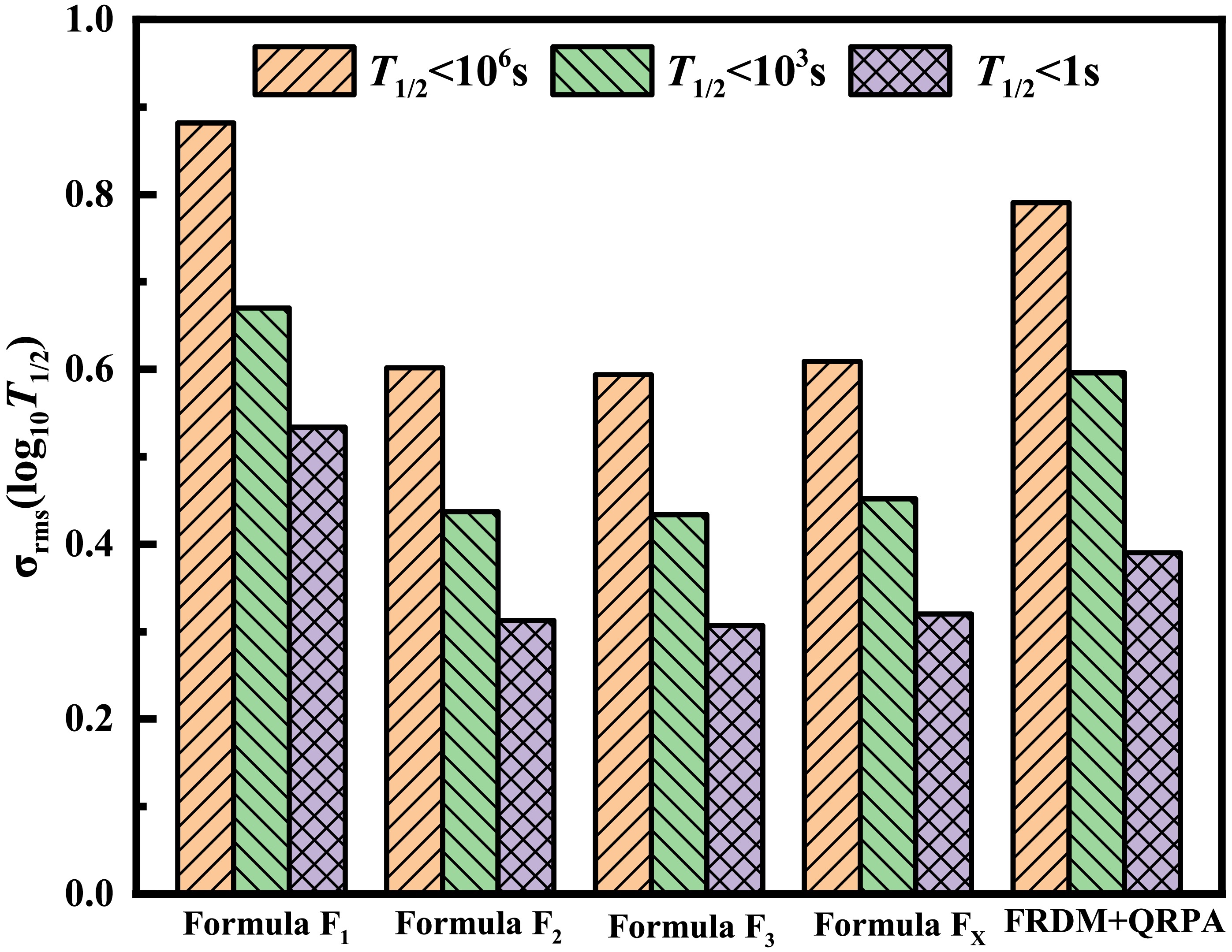
Figure 1. (color online) The rms deviations
$ \sigma_{{\rm{rms}}}(\log_{10}T_{1/2}^{{\rm{Th}}}) $ of the empirical formulas$ F_1 $ ,$F_2,$ and$ F_3 $ with respect to experimental data from NUBASE2020 [2] for three data sets$ T_{1/2}<10^{6}\; {\rm{s}} $ ,$ T_{1/2}<10^{3}\; {\rm{s}} $ , and$ T_{1/2}<1\; {\rm{s}} $ . The predictions of the empirical formula$F_{X}$ and microscopic model FRDM+QRPA are shown for comparison.To investigate the role of the transition strength in the calculation of β-decay half-lives, an empirical formula
$ F_{3}^{\prime} $ was designed by removing the transition-strength term, i.e. taking$ a_8 = 0 $ in the empirical formula$ F_3 $ . The comparison between the half-life predictions of$ F_3 $ and$ F_{3}^{\prime} $ is shown in Fig. 2, taking the Ca, Ni, Sn, and Pb isotopes as examples. It is observed that the transition strength reduces the predictions of nuclear β-decay half-lives by about an order of magnitude, indicating that transition strength plays an important role in predicting nuclear β-decay half-lives. From Eq. (8), the transition strength$ \sum B_{ {\rm{GT-}}} \rightarrow 3(N-Z) $ when$ N \gg Z $ , is in agreement with the Ikeda sum rule since the Gamow-Teller transition from$ (Z, N) $ to$ (Z-1, N+1) $ is forbidden when$ N \gg Z $ . Therefore, the transition-strength contribution gradually increases toward the neutron-rich regions with larger$ (N-Z) $ , as observed for the Ca, Ni, Sn, and Pb isotopes in Fig. 2. The heavy nuclei generally have larger$ (N-Z) $ than the light nuclei; therefore, the transition-strength contribution is generally larger in the Pb isotope than in the Ca isotope when extrapolated to the unstable neutron-rich region. This indicates that the transition-strength contribution is more important for the neutron-rich nuclei in the heavy nuclear region.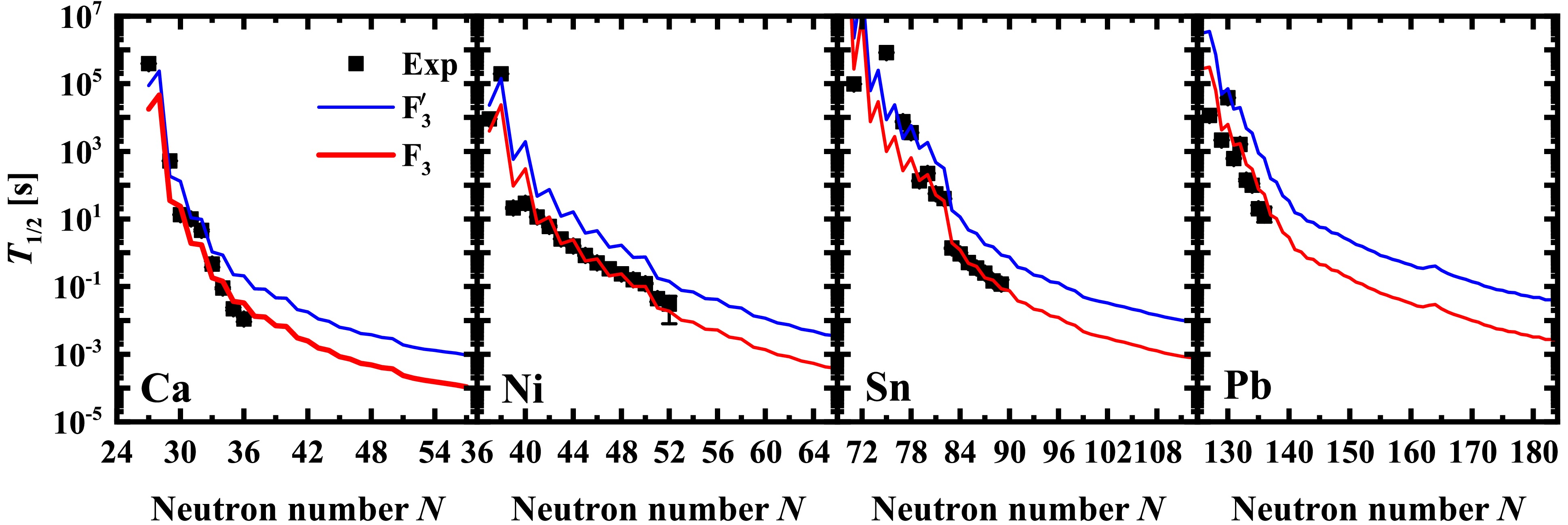
Figure 2. (color online) Nuclear β-decay half-lives of Ca, Ni, Sn, and Pb isotopes predicted by
$ F_{3}^{\prime} $ and$ F_3 $ . The experimental data from NUBASE2020 are denoted by filled squares.To compare the nuclear β-decay half-lives predicted by various empirical formulas, the predictions of
$ F_1 $ ,$ F_2 $ ,$ F_3 $ , and$F_{X}$ are shown in Fig. 3, taking the Ca, Ni, Sn, and Pb isotopes as examples. The predictions of$ F_1 $ have an excessive odd-even staggering in the known region, which$ F_2 $ ,$ F_3 $ , and$F_{X}$ effectively reduce by introducing a physical quantity δ. As discussed above, the transition-strength contribution can be effectively considered by refitting the parameters of$ F_2 $ and$F_{X}$ . Hence,$ F_2 $ ,$F_{X}$ , and$ F_3 $ generally yield very similar half-life predictions in the known region. However, the deviations between them become increasingly larger when extrapolated to the unknown region. Specifically, large deviations exist between the$F_{X}$ and$ F_3 $ predictions in the light nuclear region for Ca and Ni isotopes, and between the$ F_2 $ and$ F_3 $ predictions in the medium and heavy nuclear region for the Sn and Pb isotopes.
Figure 3. (color online) Nuclear β-decay half-lives of Ca, Ni, Sn, and Pb isotopes predicted by
$F_{X}$ ,$ F_1 $ ,$ F_2 $ , and$ F_3 $ which are shown by short dashed, dash-dotted, short-dotted, and solid lines, respectively.To show the transition-strength contribution to the half-life predictions globally, Fig. 4(a) shows the logarithmic differences between
$ F_3 $ and$ F_{3}^{\prime} $ half-life predictions. The transition-strength contribution to the nuclear β-decay half-lives was found to gradually increase toward neutron-rich or heavy nuclear regions, which is in agreement with Fig. 2. As mentioned above, the transition-strength contribution can be effectively considered by refitting the parameters of$ F_2 $ . The logarithmic differences between$ F_3 $ and$ F_2 $ half-life predictions are shown in Fig. 4(b). Clearly, the difference between$ F_3 $ and$ F_2 $ is less than$ 0.3 $ orders of magnitude for many nuclei, however, systematic overestimation of β-decay half-lives still exists for neutron-rich nuclei in heavy nuclear regions. In addition, a large systematic underestimation of β-decay half-lives is found for nuclei near the β stability line in light nuclear regions. Therefore, the inclusion of the transition-strength contribution in the empirical formula is crucial for the global description of nuclear β-decay half-lives, especially for light or heavy neutron-rich nuclei. It should be pointed out that although$ F_2 $ and$ F_3 $ provide better predictions for different nuclei, there are only a few known nuclei with large deviations between$ F_2 $ and$ F_3 $ predictions, and those are mainly concentrated in the light nuclear region near the stability line, as shown in Fig. 4. The rms deviation is an average result for all the known nuclei explaining the similar rms deviations for$ F_2 $ and$ F_3 $ in Fig. 1.
Figure 4. (color online) The logarithmic differences between the half-life predictions of (a)
$ F_3 $ and$ F_{3}^{\prime} $ , (b)$ F_3 $ and$ F_2 $ . The solid line represents the boundary of nuclei with known half-lives in NUBASE2020 [2].The logarithmic difference between the experimental half-lives and the predictions of
$ F_3 $ is shown in Fig. 5. Clearly, there are large deviations between the$ F_3 $ predictions and experimental data for the nuclei near the β stability line, whose half-life description is also a great challenge for other empirical formulas and microscopic models. For nuclei with shorter half-lives far away from the β stability line, the empirical formula$ F_3 $ can generally reproduce the experimental half-lives within$ 0.4 $ orders of magnitude.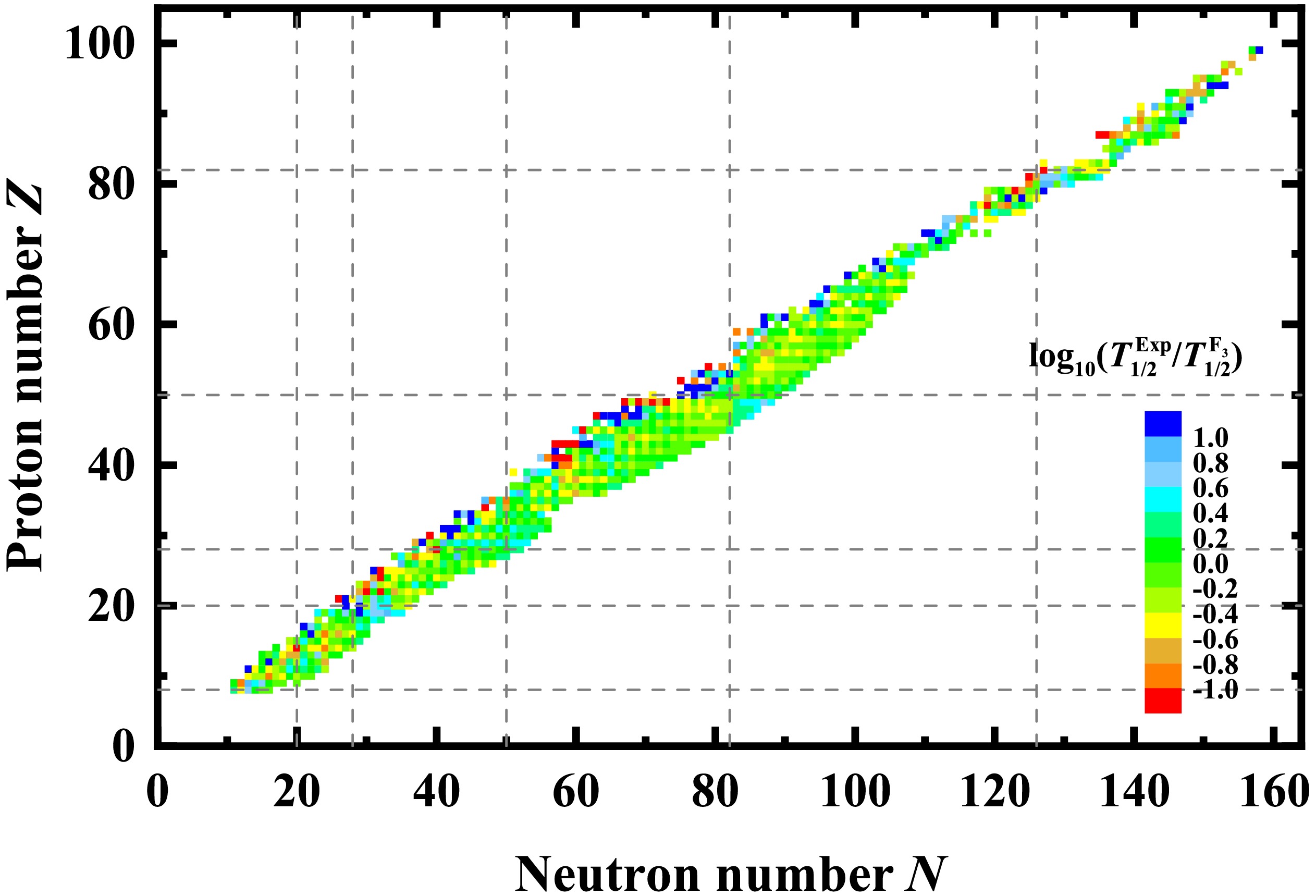
Figure 5. (color online) Logarithmic differences between the experimental β-decay half-lives and
$ F_3 $ predictions. The dashed lines denote the traditional magic numbers.Taking Ca, Ni, Sn, and Pb isotopes as examples, Fig. 6 shows the comparison between the results of
$ F_3 $ and other microscopic models, including FRDM+QRPA [37], QRPA based on the relativistic Hartree-Bogoliubov (RHB+QRPA) [38], FAM based on the Hartree-Fock-Bogoliubov model with Skyrme force (SHFB+FAM) [44], and SHFB+QRPA [51]. The predictions of$ F_3 $ are observed to be much better than other microscopic models. Quantitatively, for Ca, Ni, Sn, and Pb isotopes, rms deviations of the logarithms of FRDM+QRPA, RHB+QRPA, SHFB+FAM, and SHFB+QRPA half-life predictions from the experimental data are$ 0.833 $ ,$ 1.887 $ ,$ 0.940 $ , and$ 0.923 $ , respectively, in contrast to only$ 0.679 $ for$ F_3 $ . When extrapolated to the unknown region, the$ F_3 $ predictions are systematically shorter than those of other microscopic models for the light nuclei near the neutron-drip line, such as the Ca and Ni isotopes; whereas the$ F_3 $ predictions are between those of the other microscopic models for the heavy nuclei, such as the Pb isotopes.
Figure 6. (color online) Nuclear β-decay half-lives of Ca, Ni, Sn, and Pb isotopes predicted by
$ F_3 $ . For comparison, the theoretical results of FRDM+QRPA, RHB+QRPA, SHFB+FAM, and SHFB+QRPA are shown by the dashed, dash-dotted, short dashed, and dash-dot-dotted, respectively.The new measurements of nuclear β-decay half-lives from [52], which were not used in the fitting of the empirical formula, were further used to check the extrapolation ability of the empirical formula
$ F_3 $ , as presented in Fig. 7. The experimental data from NUBASE2020 and the results from the FRDM+QRPA model are also shown for comparison. The empirical formula$ F_3 $ reproduces the newly measured half-lives of the Pm isotopes better than the FRDM+QRPA model, which systematically underestimates these half-life data. For the Sm, Eu, and Gd isotopes, both the empirical formula$ F_3 $ and FRDM+QRPA reproduce the newly measured half-lives well. Quantitatively, the rms deviation of the logarithms of the FRDM+QRPA predictions and the newly measured data for the four isotopes is$ 0.294 $ , in contrast to only$ 0.209 $ for the empirical formula$ F_3 $ . Therefore, the empirical formula$ F_3 $ reliably predicts the nuclear β-decay half-lives, at least for nuclei not far from the known region.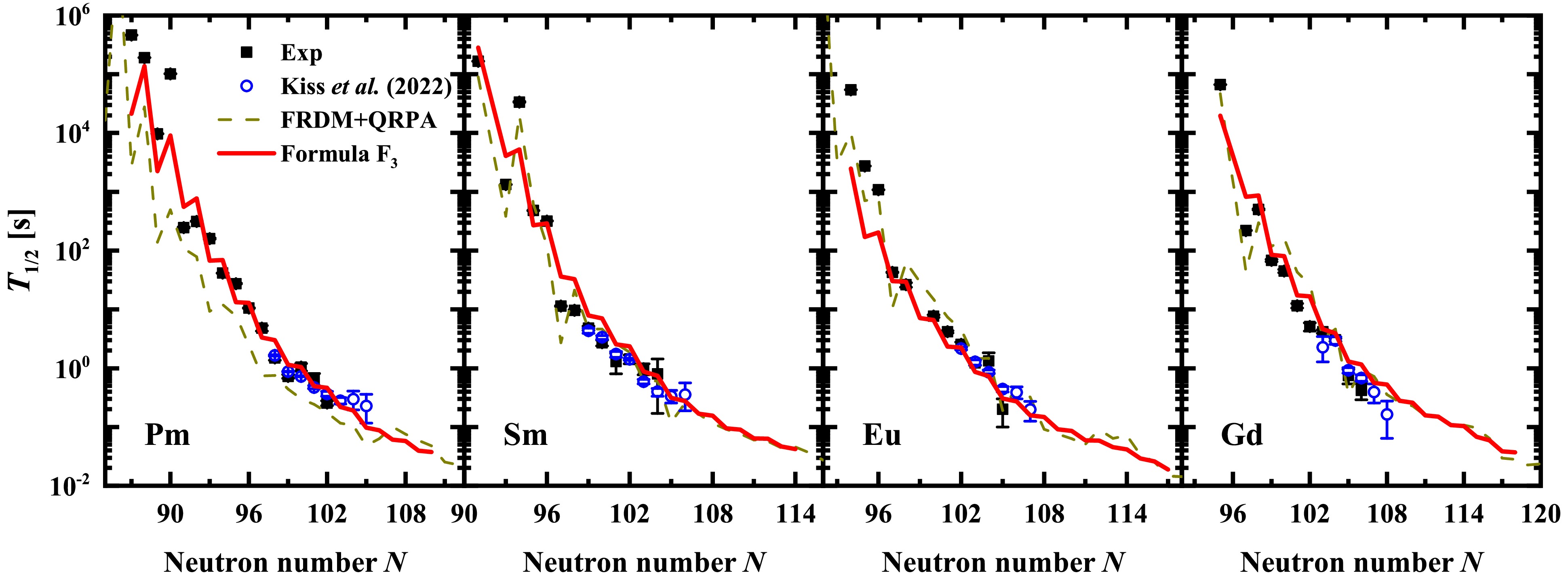
Figure 7. (color online) Nuclear β-decay half-lives for Pm, Sm, Eu, and Gd isotopes. The experimental half-lives from NUBASE2020 [2] and the newly measured data [52] are denoted by the filled squares and open circles, respectively. The FRDM+QRPA half-life predictions are shown by the dashed lines for comparison.
-
In summary, an empirical formula of nuclear β-decay half-lives that includes transition-strength contribution is proposed. The new empirical formula can describe the β-decay half-lives better than other empirical formulas and microscopic models. For nuclei with half-lives less than 1 s, the rms deviation of the logarithms of the new empirical formula predictions from the experimental data is only
$ 0.307 $ , which means that it can reproduce the experimental data within about$ 2 $ times. Thus, including the transition-strength contribution can reduce nuclear β-decay half-lives by about an order of magnitude. This effect can increase further toward neutron-rich or heavy nuclear regions with large$ (N-Z) $ . The transition-strength contribution can also be considered effectively by refitting the parameters of other empirical formulas without a transition-strength term. However, the predictions of the new empirical formula still deviate consideably for the neutron-rich nuclei in the light or heavy nuclear regions, indicating that the transition strength is crucial for the global description of nuclear β-decay half-lives. We futher analyzed the extrapolation ability of the empirical formula by comparing it to the newly measured nuclear β-decay half-lives not involved in the fitting procedure. The new empirical formula described the nuclear β-decay half-lives well, at least for nuclei not far from the known region. In the future, a high-precision nuclear β-decay half-life table will be povided for various mass models based on this empirical formula, which can be used in the r-process calculations, to further study its impact on the r-process simulations. -
We are grateful to Professor Chong Qi for the valuable suggestions.
An empirical formula of nuclear β-decay half-lives with the transition-strength contribution
- Received Date: 2024-09-30
- Available Online: 2025-04-15
Abstract: An empirical formula of nuclear β-decay half-lives is proposed by including the transition-strength contribution. The inclusion of the transition-strength contribution can reduce nuclear β-decay half-lives by about an order of magnitude, and its effect gradually increases toward the neutron-rich or heavy nuclear regions. For nuclear β-decay half-lives less than 1 s, the empirical formula can describe the experimental data within approximately2 times, which is more accurate than the sophisticated microscopic models. The transition-strength contribution can also be effectively considered by refitting the parameters of other empirical formulas without the transition-strength term although they will still significantly deviate from the new empirical formula in light or heavy neutron-rich nuclear regions. This indicates that the inclusion of the transition-strength contribution in the empirical formula is crucial for the global description of nuclear β-decay half-lives. The extrapolation ability of the new empirical formula was verified by the newly measured β-decay half-lives.





 Abstract
Abstract HTML
HTML Reference
Reference Related
Related PDF
PDF


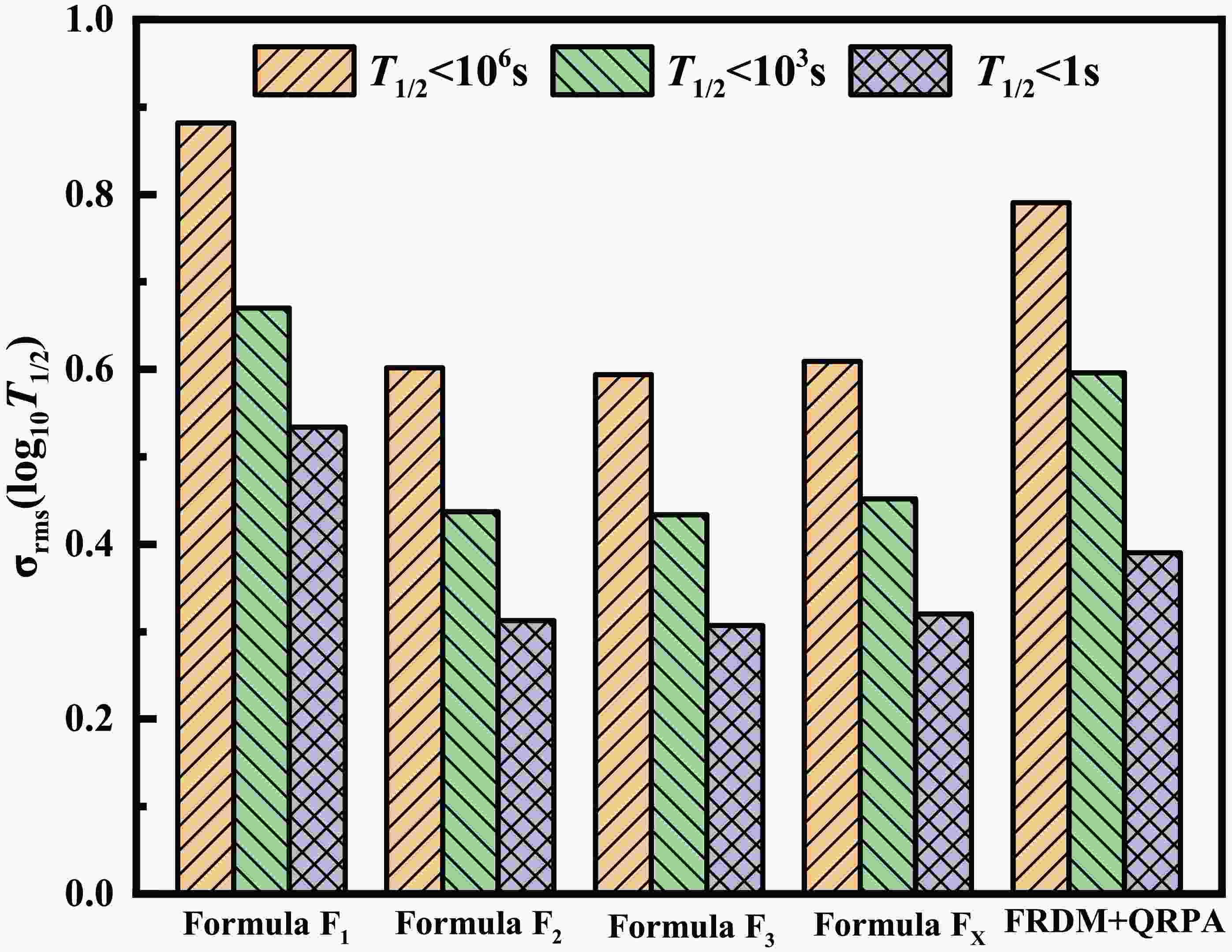













 DownLoad:
DownLoad: